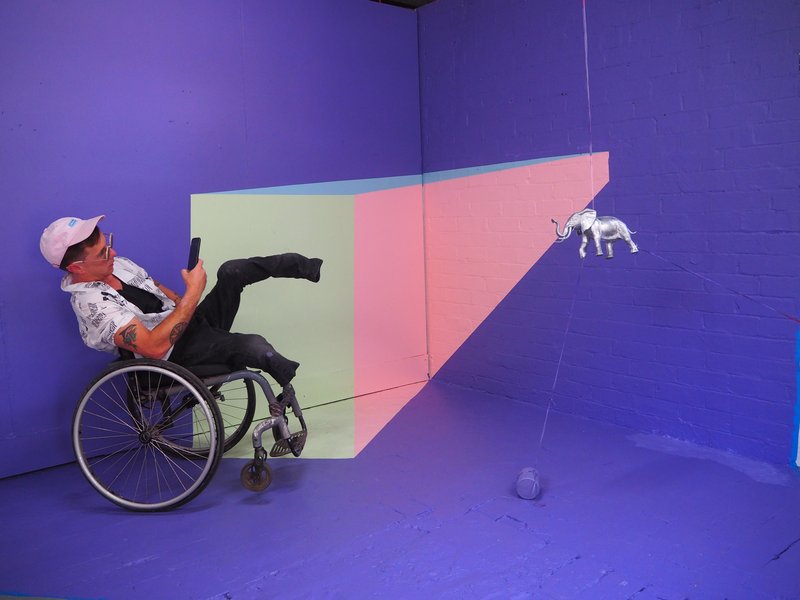Access Rights in the arts: A shared responsibility
Open and ongoing conversations about access is an important part of building and maintaining positive relationships between organisations, artists and audiences.
Open and ongoing conversations about access is an important part of building and maintaining positive relationships between organisations, artists and audiences.

Image: Bruno Booth, The elephant in the room 2019, Digital photo. Courtesy of the artist.
ID: Photo of a bright purple corner of a room with a pink, green and blue painted 3D shape in the corner. A person is rocking back on a wheelchair to take a phone photo of a silver elephant suspended on string from the ceiling. The person is wearing black pants, a white shirt, pink cap and glasses.
Decades of community activism has advocated for the rights of d/Deaf and Disabled people to participation, self-representation, employment and economic opportunity in the arts sector. While there is a great deal of goodwill in the mainstream arts and an acknowledgement that things should change, many people do not know how to go about it.
The Access Rights for d/Deaf and Disabled People section in NAVA’s newly revised Code of Practice for Visual Arts, Craft and Design (the Code) outlines the responsibilities of organisations, employers, and artists to support inclusion and participation for d/Deaf and Disabled artists and arts workers across all aspects and operations of Australia’s contemporary arts. This includes policies and procedures that support d/Deaf and Disabled peoples’ needs and boundaries, time considerations, access costs, and self-determined decision making.
Currently in Australia one in six people live with disability – 18% of the population. Disability can involve the physical, intellectual, psychiatric, sensory, neurological, immunologic, processing, learning and energy capacities of a person. Disability can also include physical difference and the presence in the body of disease-causing organisms (e.g. HIV). A person’s disability may be permanent or temporary (likely to last for at least six months), visible or ‘invisible’, and capacities may vary from day to day.
A history of siloing d/Deaf and Disabled people within the arts and cultural sector continues to give rise to economic and copyright exploitation as well as marginalisation and professional exclusion. d/Deaf and Disabled artists experience considerable barriers in employment, funding and participation in arts organisations. They may face overlapping forms of discrimination and marginalisation, such as race, gender and/or socio-economic marginalisation. First Nations communities experience Disability at more than twice the rates in non-First Nations communities. Overlapping forms of discrimination contribute to the isolation of d/Deaf and Disabled people, and reduces their capacity to articulate access needs.
Written by artist, psychologist, author and disability advocate, Debra Keenahan, in collaboration with the Code of Practice’s Disability Focus Group, the Access Rights for d/Deaf and Disabled People section is a new addition to the Code that falls under the Principles, Ethics and Rights section.
The Code outlines recommended processes and practical examples to support accessibility good practice. Acknowledging that d/Deaf and Disabled people may have conflicting access, the Code advises that good practice should be based on giving d/Deaf and Disabled people agency in how to navigate their participation and engagement in the visual arts. Similarly, it is critical to consider how intersectionality and lived experience can be incorporated into each process and action.
An important first step when considering access is to identify and remove barriers that people may experience including physical, environmental, communication, digital and structural barriers. Barriers will exist in facilities, programs and processes that were established without consideration to access. These are often simple and cost-effective to remove and can be easily identified by consulting with d/Deaf and Disabled advisors, or Disability-led organisations. Once barriers have been removed or addressed, further access can be planned for and provided. This might include specific programming, additional resources, implementing new systems, or working on collaborative projects.
Organisations have a responsibility to identify and address practices, systems, and structures in the organisation that might result in disability discrimination. A useful starting point is developing a Disability Action Plan (DAP), which can address inclusion and access requirements for all stakeholders. Other good practices include planning and budgeting for accessibility and seeking advice from experts and individuals with lived experience when making their spaces and programs accessible.
Just as organisations have accessibility responsibilities, artists should also commit to creating accessible experiences in their practices. Considering accessibility during the planning and development stages of an artwork provides greater scope for creating an accessible experience that does not deviate from or impact the intentions of the artist, but rather enables engagement by an expanded audience.
When artists and organisations are planning accessibility they must think beyond physical access and also consider the psychological impact of their work. There may be information about the work, event or program that needs to be provided to audiences such as access/trigger warnings for content, lights, sounds, smells.
Open and ongoing conversations about access is an important part of building and maintaining positive relationships between organisations, artists and audiences. A commitment to supporting Access Rights means more than just following a fixed list of instructions or rules – it involves responsive and flexible practices that allow d/Deaf and Disabled people to decide how they choose to engage with a particular work, program or event. NAVA’s Code of Practice is a good place to start, encouraging inclusion strategies paired with practical action, if we want to strive for access and inclusion in the arts.